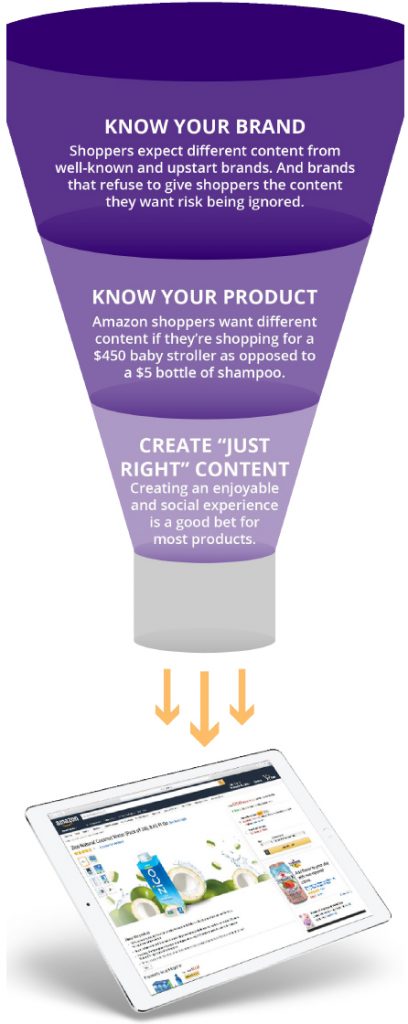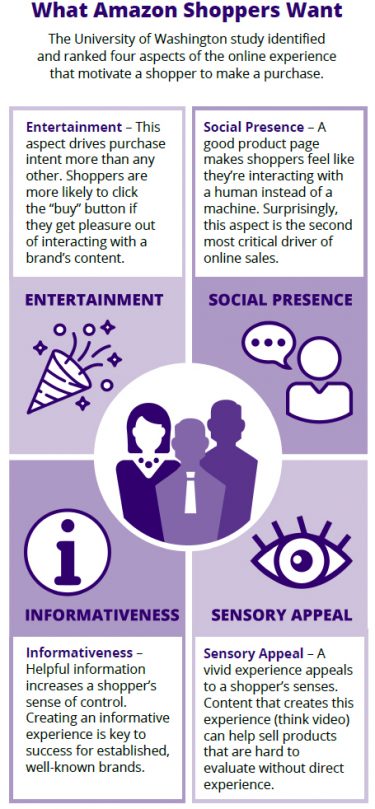Creating a ‘just right’ online shopping experience boosts sales
Amazon has become the undisputed superstore of the internet, an essential platform for most every brand—in every category—to peddle its wares. Yet many brands treat their online page content as an afterthought.
Now research from the University of Washington Foster School of Business demonstrates how carefully crafted Amazon content boosts shopper engagement and sales.
The study co-authored by Robert Palmatier, a professor of marketing and research director of Foster’s Center for Sales and Marketing Strategy, demonstrates that content optimally calibrated—in image, type, tone and text length—for the product it is selling can increase purchase intent by 15 to 20 percent.
“Brands that create an effective shopping experience on Amazon have a huge advantage over their competitors,” says Palmatier, the John C. Narver Endowed Professor in Business Administration. “It’s a matter of tailoring content for the brand and product that’s being sold.”
His study offers guidance on how to do it.
Amazon: too big to ignore
Online retail is big and getting bigger. By 2020, US retail e-commerce sales are expected to pass $460 billion, with Amazon—and its 350 million+ products on offer—leading the pack.
Beyond direct sales, Amazon is also widely seen as the premier place to research product specifications and performance reviews—even if the purchase occurs elsewhere. Studies show more than half of all product searches originate on Amazon.
But being on Amazon does not guarantee sales.
To find out what type of content converts browsers to buyers, Palmatier collaborated with Alexander Bleier, an assistant professor of marketing at the Frankfurt School of Finance & Management, and Colleen M. Harmeling, an assistant professor of marketing at Florida State University.
The researchers analyzed the interactions and transactions of more than 10,000 Amazon shoppers. They partnered with content26, a Seattle-based developer of Amazon advertising and content strategies, to create 256 “Amazon look-alike” product pages for a variety of packaged goods, consumables and electronics. These allowed them to test 13 different product page elements.
This analysis revealed a clear conclusion: brands that create effective online “storefronts” (product pages) can expect to see a significant boost in shopper satisfaction and sales.
But what makes for an effective Amazon storefront? It depends on what kind of product you’re selling.
Getting to “just right”
Palmatier’s research team drew three major recommendations from the data.
 Know your brand. Shoppers expect different content from well-known and upstart brands. Established brands benefit from building informative shopping experiences with enhanced content and plenty of detail. Newcomers need to focus on creating vivid experiences—such as a video of the product in use—to help shoppers engage emotionally and create a sense of trust that the product does what it promises. “Brands that don’t give shoppers the content they want risk being ignored,” Palmatier says.
Know your brand. Shoppers expect different content from well-known and upstart brands. Established brands benefit from building informative shopping experiences with enhanced content and plenty of detail. Newcomers need to focus on creating vivid experiences—such as a video of the product in use—to help shoppers engage emotionally and create a sense of trust that the product does what it promises. “Brands that don’t give shoppers the content they want risk being ignored,” Palmatier says.
Know your product. Amazon shoppers want different content if they’re shopping for a $450 baby stroller as opposed to a $5 bottle of shampoo. Complex products benefit from vivid experiences. But vivid marketing can be a distraction for more utilitarian products, which might more effectively be advertised on competitor pages.
Create “just right” content. Presenting an enjoyable and social experience is a good bet for most products.
“In an era in which web design is becoming increasingly important,” Palmatier says, “sellers’ success depends on their ability to employ design elements on product web pages to evoke effective customer experiences that not only convey information but also entertain, imply human interactions, and mimic sensory experiences from the offline world.”
What Amazon shoppers want
Getting the content on an e-commerce site “just right” means paying close attention to the kind of product on offer—and creating a complementary experience. Palmatier and his co-authors identified and ranked four key aspects of the online experience that motivate a shopper to make a purchase.
 Entertainment – this aspect drives purchase intent more than any other. Shoppers are more likely to click the “buy” button if they get pleasure out of interacting with a brand’s content.
Entertainment – this aspect drives purchase intent more than any other. Shoppers are more likely to click the “buy” button if they get pleasure out of interacting with a brand’s content.- Social Presence – a good product page makes shoppers feel like they’re interacting with a human instead of a machine. This can be accomplished by showing a product in use, keeping the tone informative but conversational, and keeping it brief. Surprisingly, this aspect is the second most critical driver of online sales. It is especially important for products that provide pleasure or activate the senses (such as a smart phone or stylish headphones).
- Informativeness – helpful information increases a shopper’s sense of control. Creating an informative experience is key to success for established, well-known brands. Information is especially important in selling products that are utilitarian (such as diapers and shampoo), and products with features that are easy to evaluate (such as tools) or complex (such as laptop computers or window blinds).
- Sensory Appeal – A vivid experience appeals to a shopper’s senses. Content that creates this experience (such as video) can help sell products that are hard to evaluate without direct sensory experience. A vivid experience is especially important for products that are difficult to qualify (lipstick, books, wine) and which have complex features.
Palmatier says that online content pages allow marketers to showcase products in unprecedented and exciting ways. But aligning the presentation with the product is essential to converting sales.
“Brands that want to keep up with the competition need to begin paying as much attention to their Amazon shelves as they do to their brick-and-mortar offerings,” he adds. “Effective content holds the key to connecting with Amazon shoppers and providing a branded experience within Amazon.”
“Creating Effective Online Customer Experiences” is published in the March 2019 Journal of Marketing.
Learn more about the study and UW Foster’s Center for Sales and Marketing Strategy.

